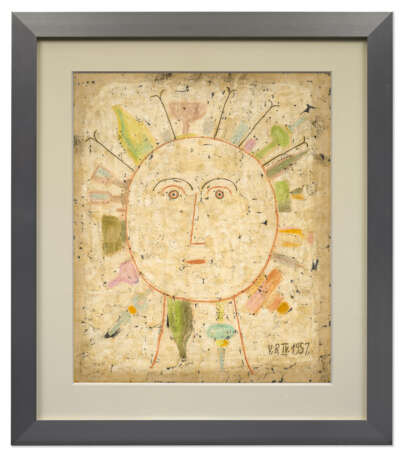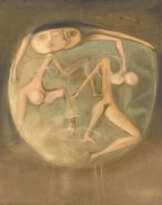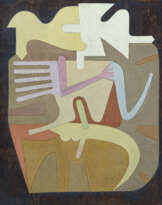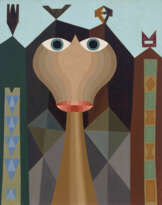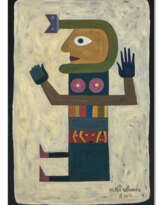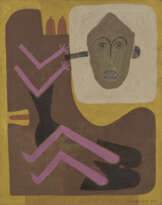ID 930372
Лот 165 | Victor Brauner (1903-1966)
Оценочная стоимость
€ 70 000 – 100 000
Offrandes
signé des initiales et daté ‘V,B, IV,1957,’ (en bas à droite); inscrit indistinctement ‘CONSIGNATION L’OFFRANDE”’ (au revers)
cire à l'encaustique, huile, crayon gras et encre sur carton d'artiste
65 x 54 cm.
Exécuté en avril 1957
signed with the initials and dated ‘V,B, IV,1957,’ (lower right); indistinctly inscribed ‘CONSIGNATION L’OFFRANDE”’ (on the reverse)
encaustic wax, oil, wax crayon and ink on canvasboard
25 5/8 x 21 1/4 in.
Executed in April 1957
Provenance
Michel Angel, France (acquis auprès de l'artiste vers 1960).
Puis par descendance au propriétaire actuel.
Special notice
Artist's Resale Right ("droit de Suite").
If the Artist's Resale Right Regulations 2006 apply to this lot, the buyer also agrees to pay us an amount equal to the resale royalty provided for in those Regulations, and we undertake to the buyer to pay such amount to the artist's collection agent.
Post lot text
Peint en 1957, Offrandes représente la tête d’un personnage faisant face au spectateur et fut réalisée avec une absence totale de réalisme et de perspective. Des lignes simples et colorées tracent un visage minimaliste, sans expression, couronné par une auréole faite de bouteilles et de verres.
Bien que stylistiquement très simple, ce travail est imprégné d’une signification inconnue. Les compositions de créatures fantastiques de Brauner peuvent être perçues comme des exercices allant dans le sens d’une dépersonnalisation de la forme humaine, conçue comme un moyen par lequel l’artiste peut exprimer et explorer ses propres angoisses. Il semble probable que les bouteilles et les verres évoquent aussi cela. Comme pour la plupart de ses contemporains, le seconde guerre mondiale a eu un impact profond sur lui; étant juif et étranger, Brauner a été forcé de se cacher dans le Sud de la France en 1943, ayant fuit en 1940 la ville de Paris si chère à son coeur. Cette période de solitude et de peur intense se manifestera directement dans l'oeuvre artistique de Brauner durant tout le restant de sa vie. En effet, dès juin 1945, Brauner a écrit à son camarade surréaliste André Breton, lui confiant que son inspiration se concentrait désormais sur autre chose, avec le désir de poursuivre le surréalisme comme « la seule méthode possible pour délivrer l’homme de…. la solitude de la vie moderne ».(C. Morando, Nous Victor Brauner, Paris, 2020, p.160)La délicate matière apportée par la cire qui couvre l’image contraste avec la platitude du personnage. Cette technique a été découverte par Brauner durant la guerre, plus précisément entre 1942 et 1943, quand une pénurie de peinture et sa recherche de moyens d’expressions plus directs ont convergé. Des matériaux simples comme la cire de bougie ou d’autres techniques mixtes ont facilité un «style nouveau, féroce et sommaire, apparemment grossier mais intensément expressif» (J. Beauffet, Victor Brauner, Paris, 1990, p. 38).S’étant écarté d’un précédent style plus élaboré et plus proche du Surréalisme - comme nombre d’autres artistes contemporains qui étaient aussi ses amis comme Yves Tanguy - l’esthétique plus brute et aplatie de Offrandes est représentative des travaux plus tardifs de Brauner. Cela est aussi probablement dû en partie à la perte de vision progressive de Brauner, qui perdit un oeil lors d’une bagarre dans un bar en 1938. Une telle purification de la forme et de la technique constitue un retour aux principes fondamentaux de la création artistique, particulièrement lorsque l’on considère que 1957 correspond à la fin des expérimentations longues et variées de Brauner au sein du Dadaïsme, du Surréalisme et de l’avant-garde. À partir de ce moment-là, Brauner s’est de plus en plus concentré sur des créatures et des êtres fantastiques et totémiques, réalisés dans des couleurs vives, des formes simplifiées, qui rappellent graffitis et peintures rupestres. Influencées par l’art non-européen - particulièrement par l’iconographie ancienne provenant du Mexique et d’Amérique Latine, mais aussi par des travaux de Paul Klee et Max Ernst - ces oeuvres offrent un regard fascinant dans le répertoire hautement personnel des personnages mystérieux créés par Brauner. Ce travail anticipe son intérêt futur pour cette technique et peut être perçu comme une exploration précoce par l’artiste de cette nouvelle forme d’expression.À propos de l'œuvre de Brauner, Susan Davidson a écrit « homme érudit et avec un grand intellect, Brauner faisait des tableaux qui avaient souvent des qualités s’apparentant à l’art naïf et populaire. D’abord axés sur de la figuration - que ce soit avec des êtres humains, animaux, occultes ou mythologiques - ses travaux sont pourtant souvent réalisés dans des formes abstraites colorées audacieusement et imprégnées d’étendues de motifs bi-dimensionnels. Alors que ses tableaux semblent souvent directs, faits de thématiques simples et invoquant des images de livres d’enfants, ils sont en fait étayés par un lexique de symbolisme et d'archétypes qui tissent un paysage lourd de significations" (Victor Brauner, Hiéroglyphes surréalistes, cat. exp., The Menil Collection, Houston, 2001, p. 9).
Painted in 1957, Offrandes depicts a figure’s head, face on to the viewer and rendered with the total elimination of perspective and naturalism. Simplistic, colourful lines sketch out an pared-back, expressionless face, crowned with a halo of bottles and glasses. Although stylistically simple, the work is imbued with unknown meaning. Brauner’s compositions of fantastical creatures can be regarded as exercises in the depersonalization of the human form, intended for a vehicle through which the artist could express and explore his own anxieties. It seems likely that the bottles and glasses speak to this. Like most of his contemporaries, the Second World War had a profound impact; being Jewish and a foreigner, Brauner was forced into hiding in the South of France in 1943, having fled his beloved Paris in 1940. This period of intense fear and loneliness can be seen as manifesting itself in Brauner’s artwork throughout the remainder of his life. Indeed, as early as June 1945, Brauner wrote to fellow Surrealist André Breton, confiding in him that his inspiration had taken on a new focus, with a desire to pursue surrealism as the “only possible method to ‘deliver man from …the loneliness of modern life.” (C. Morando, Nous Victor Brauner, Paris, 2020, p.160) The delicately materialistic effect of the wax that veils the image is contrasted against the flatness of the figure. The technique first came to Brauner’s attention during the war, specifically between 1942-1943, whereby a shortage of paints and the aforementioned search for a more direct means of expression converged. Simple materials such as candle wax and various other mixed media facilitated a ‘new fierce and perfunctory style, seemingly crude but intensely expressive’. (J. Beauffet, Victor Brauner, Paris, 1990, p.38)
Having moved away from an earlier, more high Surrealist style - alike to contemporaneous artists and friends such as Yves Tanguy - the bold, flattened aesthetic seen here characterized Brauner’s later works. This is perhaps in part due to Brauner’s increasing loss of vision in his left eye, which was left enucleated after a bar fight in 1938. Such purification of form and technique serves as a return to the basic tenets of artmaking, particularly when considering that 1957 was nearing the end of Brauner’s long and varied practice of experimentation in Dada, Surrealism, and the Avant-Garde. By this time, Brauner’s work focused increasingly on totemic fantastical beings and creatures, realised in brightly coloured, simplified forms, reminiscent of ancient cave paintings or graffiti. Influenced by non-European art – particularly ancient Mexican and South American iconography, as well as works by Paul Klee and Max Ernst - they offer a captivating glimpse into Brauner’s highly personal lexicon of mysterious characters. This work only just predates this later focus, and can be recognized as a precursory exploration by the artist into a new form of expression.
Of Brauner's oeuvre, Susan Davidson has written, "An erudite man of high intellect, Brauner made paintings that often have a naïve, folk art quality. Primarily focusing on figuration - whether human, animal, occult or mythological beings - his works conversely are often realized in boldly coloured abstract shapes permeated by expanses of decorative two-dimensional patterning. While his paintings often seem thematically simple and straightforward, invoking images from a child's storybook, they are in fact underpinned by a lexicon of symbolism and archetypes that weaves an intricate tapestry of meaning" (Victor Brauner, Surrealist Hieroglyphs, exh. cat., The Menil Collection, Houston, 2001, p. 9).
| Автор: | Виктор Браунер (1903 - 1966) |
|---|---|
| Категория аукционного дома: | Картины |
| Автор: | Виктор Браунер (1903 - 1966) |
|---|---|
| Категория аукционного дома: | Картины |
| Адрес торгов |
CHRISTIE'S 9 Avenue Matignon 75008 Paris Франция | ||||||||||||||
|---|---|---|---|---|---|---|---|---|---|---|---|---|---|---|---|
| Предосмотр |
| ||||||||||||||
| Телефон | +33 (0)1 40 76 85 85 | ||||||||||||||
| Факс | +33 (0)1 40 76 85 86 | ||||||||||||||
| Условия использования | Условия использования | ||||||||||||||
| Транспортировка |
Почтовая служба Курьерская служба Самовывоз | ||||||||||||||
| Способы оплаты |
Банковский перевод | ||||||||||||||
| Часы работы | Часы работы
|



